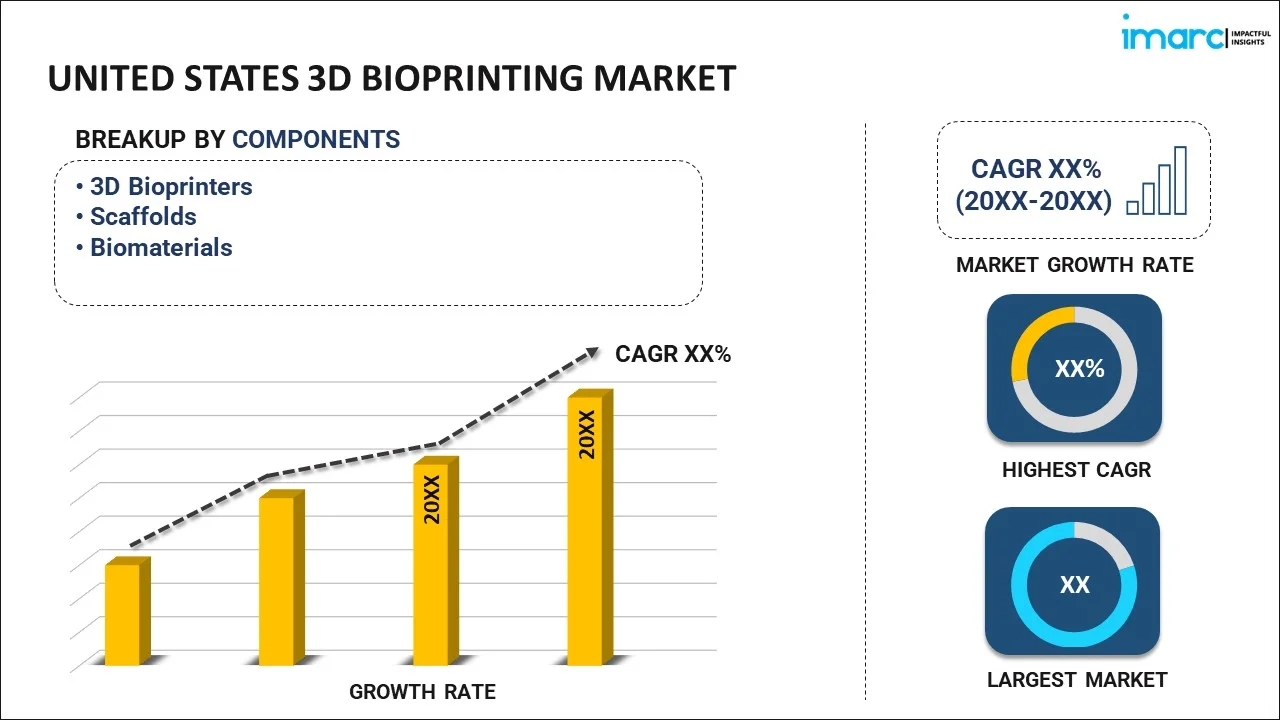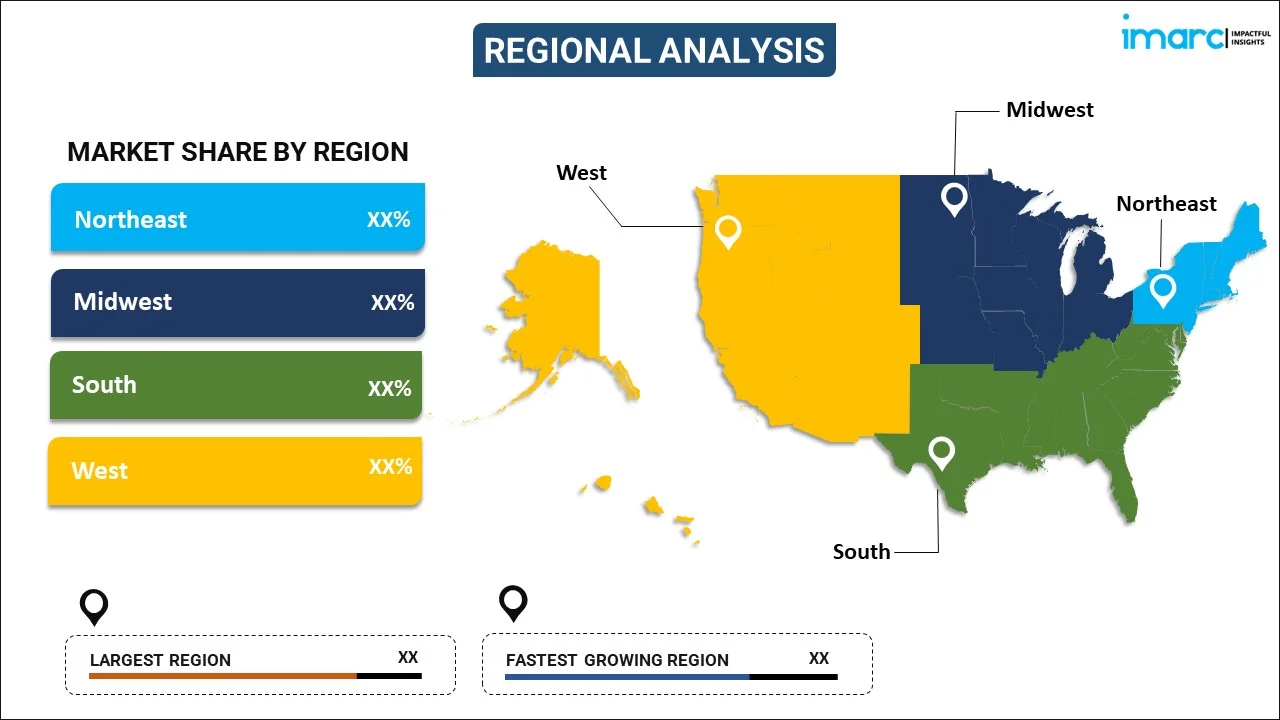
United States 3D Bioprinting Market Report by Component (3D Bioprinters, Scaffolds, Biomaterials), Application (Research, Clinical), End User (Hospitals, Research Organization and Academic Institutes, Biopharmaceuticals Companies), and Region 2025-2033
Market Overview:
United States 3D bioprinting market size is projected to exhibit a growth rate (CAGR) of 12.73% during 2025-2033. The escalating demand for this technology that can revolutionize personalized medicine, tissue engineering, and organ transplantation has spurred investments and collaborations across academia, healthcare institutions, and industry players, which is primarily driving the market growth.
|
Report Attribute
|
Key Statistics
|
|---|---|
|
Base Year
|
2024 |
|
Forecast Years
|
2025-2033 |
|
Historical Years
|
2019-2024
|
| Market Growth Rate (2025-2033) | 12.73% |
3D bioprinting involves utilizing 3D printers in the medical field to construct biological tissues and organs by layering living cells. This process establishes controlled patterns in three dimensions, preserving the viability and function of cells within the printed structure. The technique employs a layer-by-layer approach to deposit substances like bio-inks, which are derived from living cells, biomaterials, and active biomolecules. These bio-inks are instrumental in forming the 3D framework of tissues and organs. The technology not only enables swift and precise drug testing by allowing potential drug compounds to be assessed on bio-printed tissue before advancing to human trials but also facilitates the creation of intricate bodily structures, such as bones, skin, vascular grafts, tracheal splints, heart tissues, cartilages, etc. Consequently, 3D bioprinting plays a crucial role in advancing research and development activities related to drugs, scaffolds, and medical implants.
United States 3D Bioprinting Market Trends:
The United States 3D bioprinting market is witnessing remarkable growth as a result of technological advancements and the increasing recognition of its potential in the medical field. Moreover, in the nation, this technology is gaining prominence for its applications in drug testing, enabling the assessment of potential drug compounds on bio-printed tissues for enhanced accuracy before progressing to human trials, which is acting as another significant growth-inducing factor. Furthermore, 3D bioprinting is contributing widely to the field of regenerative medicine, allowing for the fabrication of complex bodily structures, including bones, skin, vascular grafts, tracheal splints, heart tissues, and cartilages, which is positively influencing the regional market. Besides this, the United States stands at the forefront of research and development in 3D bioprinting, with a robust market that caters to the growing demand for advanced healthcare solutions. Additionally, as the country continues to foster innovation and explore new applications for 3D bioprinting, the market is poised for sustained expansion over the forecasted period.
United States 3D Bioprinting Market Segmentation:
IMARC Group provides an analysis of the key trends in each segment of the market, along with forecasts at the country level for 2025-2033. Our report has categorized the market based on component, application, and end user.
Component Insights:

- 3D Bioprinters
- Syringe/Extrusion Bioprinting
- Inkjet Bioprinting
- Magnetic Levitation Bioprinting
- Laser-assisted Bioprinting
- Others
- Scaffolds
- Biomaterials
- Living Cells
- Hydrogels
- Extracellular Matrices
- Others
The report has provided a detailed breakup and analysis of the market based on the component. This includes 3D bioprinters (syringe/extrusion bioprinting, inkjet bioprinting, magnetic levitation bioprinting, laser-assisted bioprinting, and others), scaffolds, and biomaterials (living cells, hydrogels, extracellular matrices, and others).
Application Insights:
- Research
- Drug Research
- Regenerative Medicine
- 3D Cell Culture
- Clinical
- Skin
- Bone and Cartilage
- Blood Vessels
- Others
A detailed breakup and analysis of the market based on the application have also been provided in the report. This includes research (drug research, regenerative medicine, and 3D cell culture) and clinical (skin, bone and cartilage, blood vessels, and others).
End User Insights:
- Hospitals
- Research Organization and Academic Institutes
- Biopharmaceuticals Companies
The report has provided a detailed breakup and analysis of the market based on the End User. This includes hospitals, research organization and academic institutes, and biopharmaceuticals companies.
Regional Insights:

- Northeast
- Midwest
- South
- West
The report has also provided a comprehensive analysis of all the major regional markets, which include Northeast, Midwest, South, and West.
Competitive Landscape:
The market research report has also provided a comprehensive analysis of the competitive landscape. Competitive analysis such as market structure, key player positioning, top winning strategies, competitive dashboard, and company evaluation quadrant has been covered in the report. Also, detailed profiles of all major companies have been provided.
United States 3D Bioprinting Market Report Coverage:
| Report Features | Details |
|---|---|
| Base Year of the Analysis | 2024 |
| Historical Period | 2019-2024 |
| Forecast Period | 2025-2033 |
| Units | Million USD |
| Scope of the Report | Exploration of Historical Trends and Market Outlook, Industry Catalysts and Challenges, Segment-Wise Historical and Future Market Assessment:
|
| Components Covered |
|
| Applications Covered |
|
| End Users Covered | Hospitals, Research Organization and Academic Institutes, Biopharmaceuticals Companies |
| Regions Covered | Northeast, Midwest, South, West |
| Customization Scope | 10% Free Customization |
| Post-Sale Analyst Support | 10-12 Weeks |
| Delivery Format | PDF and Excel through Email (We can also provide the editable version of the report in PPT/Word format on special request) |
Key Questions Answered in This Report:
- How has the United States 3D bioprinting market performed so far and how will it perform in the coming years?
- What has been the impact of COVID-19 on the United States 3D bioprinting market?
- What is the breakup of the United States 3D bioprinting market on the basis of component?
- What is the breakup of the United States 3D bioprinting market on the basis of application?
- What is the breakup of the United States 3D bioprinting market on the basis of end user?
- What are the various stages in the value chain of the United States 3D bioprinting market?
- What are the key driving factors and challenges in the United States 3D bioprinting?
- What is the structure of the United States 3D bioprinting market and who are the key players?
- What is the degree of competition in the United States 3D Bioprinting market?
Key Benefits for Stakeholders:
- IMARC’s industry report offers a comprehensive quantitative analysis of various market segments, historical and current market trends, market forecasts, and dynamics of the United States 3D bioprinting market from 2019-2033.
- The research report provides the latest information on the market drivers, challenges, and opportunities in the United States 3D bioprinting market.
- Porter's five forces analysis assist stakeholders in assessing the impact of new entrants, competitive rivalry, supplier power, buyer power, and the threat of substitution. It helps stakeholders to analyze the level of competition within the United States 3D bioprinting industry and its attractiveness.
- Competitive landscape allows stakeholders to understand their competitive environment and provides an insight into the current positions of key players in the market.
Need more help?
- Speak to our experienced analysts for insights on the current market scenarios.
- Include additional segments and countries to customize the report as per your requirement.
- Gain an unparalleled competitive advantage in your domain by understanding how to utilize the report and positively impacting your operations and revenue.
- For further assistance, please connect with our analysts.
 Inquire Before Buying
Inquire Before Buying
 Speak to an Analyst
Speak to an Analyst
 Request Brochure
Request Brochure
 Request Customization
Request Customization




.webp)




.webp)












